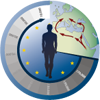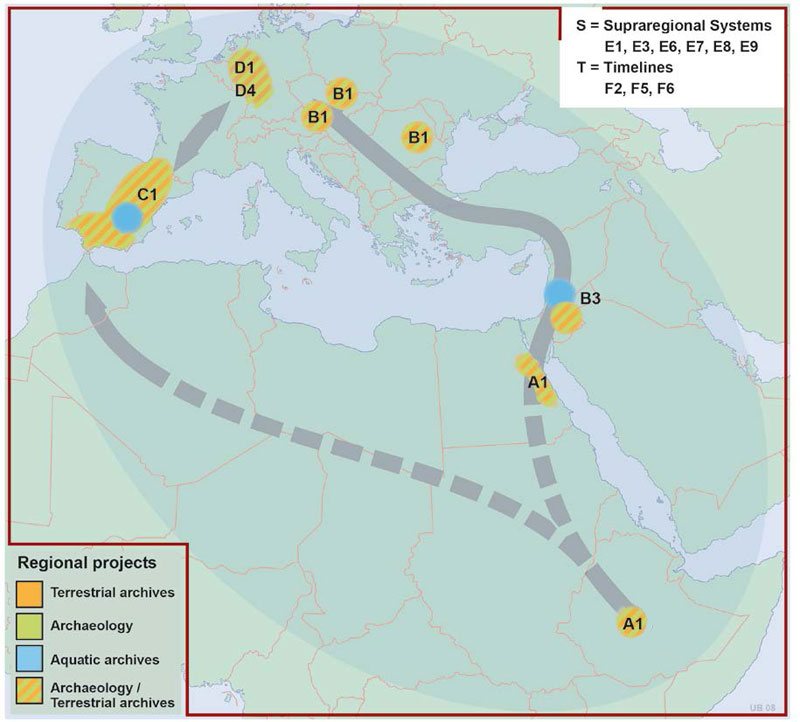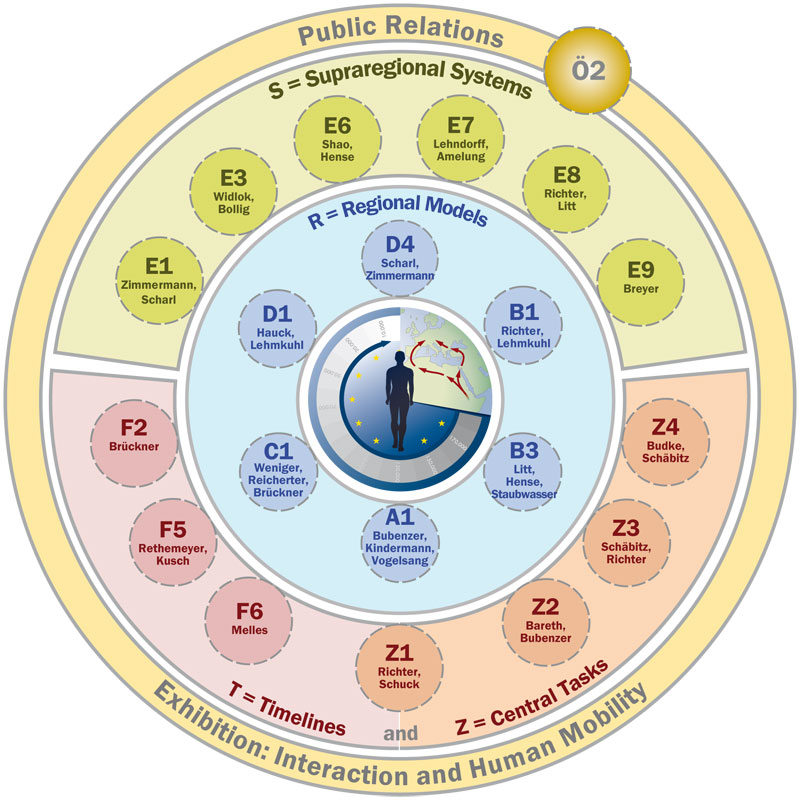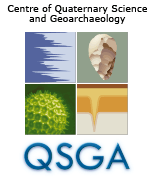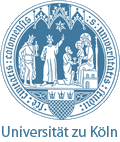Research profile of the Collaborative Research Centre 806 (Phase3)
3rd Funding Period 2017-2021
The cultural-environmental context of the spread of anatomically modern humans (AMH) from their cradle in Africa to one of their “sinks” (Central Europe) is the focus of the CRC 806 (SFB 806) “Our Way to Europe”, since its start in 2009. With archaeological and geoscientific methods the projects of the Regional Group (former Cluster A to D) follow the main migration routes of our ancestors out of Africa and into Europe in order to reconstruct past climates, cultures, population changes and living conditions to understand the push and pull factors of the dispersal and retreat of our ancestors. Similar to the first two phases of the CRC 806 (the last seven years) the complete timeframe (MIS 6 to MIS 1) to be studied in our project differs by region: In East-Africa it started about 190,000 years ago (during MIS 6) with the first appearance of AMH in Ethiopia. Their dispersal into in the Middle East (and to other African regions) followed – based on results from different research fields outside the CRC 806 - during MIS 5 to MIS 3 in several “waves”, which did not all end successfully: i.e with the long-lasting dominance of our ancestors in these new regions. Especially in the Middle East they might be first have been hampered by the Neanderthals, but came back during MIS 4 to MIS 3 when they managed to move forward into SE-Europe. On our Western corridor MIS 5 to MIS 2 are relevant time frames while in Central Europe the spread of AMH happened during MIS 3/4 until MIS 1.
What were the main triggers supporting or preventing this mobility? So far we have indications that it was a set of reasons working together that certainly differed in time and space: climate, environment and cultural contexts as well as population densities. It is discussed (Stringer 2011: 221) that population increase is one of the critical factors in building up and conserving behavioural novelties in ancient human communities. These new behavioural strategies should have also pushed people forward to be best adapted for new challenges in new regions. First results from our long core sedimentological records from the site of Chew Bahir (S-Ethiopia) point exactly in this direction: After a generally wetter but frequently changing climate during the end of MIS 5 the climate changed to dryer and generally more stable (= less frequent changes) conditions during MIS 4 and early MIS 3, when the people successfully left East Africa according to recent knowledge based on the L3 mtDNA genetic results. This coincidence is worth studying in more details and should be checked by different models as one focus during the proposed third funding period of our CRC 806.
This is only one example of how the “old” main research questions (Number 19) already presented in our first proposal became focussed during the second phase and will guide us during the last. Meanwhile, after very effective data gathering in the last 7 years, we will step by step concentrate more on the integration and modelling of data gained from different methods. This for us is the only way to interpret and prove the different hypotheses of push and pull factors behind human dispersal. And who else would have better circumstances to do so ? The CRC 806 is the only research project covering such a vast area (Fig. 1) from Africa up to Central Europe over such a long-time frame and created recently so many local data with different methods in order to understand the complex pattern of human dispersal.
|
|
|
|
The circular form symbolises the integrative attempt of the 3rd CRC 806 phase based on the former Regional Clusters, which are now reduced in numbers and centred as the new Regional Models Group (subprojects A1, B1, B3, C1, D1 and D4). In the Regional Group subprojects (former shown in Regional Clusters A to D) we will concentrate on the remaining very important sites and their final data analysis and interpretation.
The Regional Models group subprojects will be supported by data and results originating from the Timelines Group (containing subprojects F2, F5 and F6), which unite the different dating methods. All mentioned subprojects will closely interact and cooperate with the new Supraregional System Group subprojects in which modelling based on different methods is the main focus for E1, E3, E6, while the three new subprojects will deliver new insights about the black carbon remains in most of the analysed sites (E7 = former D6), the faunal assemblages based on a reconstruction of the regional biomes for MIS 3 (E8) and the general relation between humans and things on a philosophical basis (E9). The Z-Group unifies the management of administration (Z1), the data management (Z2), the education for the graduate students (= Integrated Research Training Group IRTG: Z3) and the school project (Z4). Last but not least with an extraordinary importance the (already granted) Exhibition Subproject will be our main outreach and transmission activity to connect our results to a broader audience.
Phase 1+2
Our Way To Europe concerns the history of mankind. We specifically intend to approach this with a combination of geoscientific and archaeological methods. Population dynamics and dispersal processes contributed essentially to the transmission of ideas, techniques, cultural behaviour and the formation of human societies.
Major events in the history of mankind resulted due to dispersal processes. Human agency, climate and environment were certainly among the principal factors driving population mobility. Explanatory models require data, indicating to which extent single events of migration and dispersal were either supported or limited by environmental conditions in the source areas, corridors and target areas of population movements.
|
|
| Figure 1: Our Way to Europe: Origins ("source"), corridors of diffusion ("trajectories"), periphery ("sink") and key areas selected for contextual research with special respect of the adaptive width of the human niche, given by limiting natural factors in particular regions. The human niche is considered as a product of cultural, environmental and climatic factors, thus defining the three principal disciplinary branches - corresponding to archaeological, terrestrial and aquatic archives - involved in our research strategy |

The Collaborative Research Centre (CRC; ‘Sonderforschungsbereich’ or SFB) is designed to capture the complex nature of chronology, regional structure, climatic, environmental and socio-cultural contexts of major intercontinental and transcontinental events of dispersal of Modern Man from Africa to Western Eurasia, and particularly to Europe.
The CRC will concentrate on the time span between the dispersal of Modern Man from Africa and the permanent establishment of Man in Central Europe. The time span of investigation comprises the last 190,000 years, thus including the second-last glacial (Marine Isotopic Stage, MIS 6), the last interglacial-glacial cycle (MIS 5 to 2) and the Holocene (MIS 1).
The CRC will focus on three major themes:
First theme:
The climatic, environmental and cultural context of the primary expansion of our species, particularly Modern Man's dispersal from Africa after 190,000 a1 and the occupation of Europe by 40,000 a.
Second theme:
Secondary occurrences of expansion and retreat of our species, induced by climatic, environmental or cultural changes, for instance the reoccupation of the Near East in the Middle Weichselian and the re-occupation of extensive parts of Europe after the end of the Last Glacial Maximum, resulting in the spread and establishment of Neolithic economy throughout Europe.
Third theme:
Population changes, mobility and migration in coupled cultural and environmental systems, driven by growing impact of human agency on the environment, particularly dispersal, retreat and internal mobility among sedentary prehistoric societies.
The CRC seeks to understand the environmental driving forces of these developments and their possible interactions with the cultural system. The CRC envisages a principally structural and methodological perspective, involving several case studies for comparative reasoning. The CRC will tackle this goal by investigating a broad range of environmental conditions at local, regional and continental scales, including actions and reactions of human populations in terms of emigration, immigration or acculturation. The relevant forces have to be evaluated within a multifactor, and presumably not always linear, system of relationships based on the comparison of case studies that have been systematically selected. Present discussions on environmental determinism and the role of human agency would benefit from broader perspectives, based on long-term datasets. Observation of long-term developments could help evaluate potentials for innovation or expansion, resilience and sustainability of pre-industrial cultural systems.
Research Programme
The research strategies of the CRC correspond to the three principal themes mentioned above.
First theme:
The climatic, environmental and cultural context of the primary expansion of our species, particularly Modern Man's dispersal from Africa after 190,000 a and the occupation of Europe by 40,000 a.
All of us, all humans presently living on Earth, belong to the same species: Homo sapiens sapiens. A majority within the scientific community supports the "Out of Africa II" or “Black Eve” hypothesis assuming that Homo sapiens sapiens originated in East Africa around 190,000 years ago, and dispersed from there towards the rest of Africa, Eurasia, Australia and finally to the Americas.
Two principal findings from different disciplines have yielded evidence for the “Black Eve” theory: First, geneticists have reconstructed a family tree of Modern Man with its roots in Eastern Africa, based mainly on worldwide comparisons of the mitochondrial DNA (mtDNA) of present-day humans. Second, the earliest fossils of Homo sapiens sapiens have been found in Eastern Africa, and relatively old fossils have been found in Southern Africa and the Near East, which led physical anthropologists to support the idea of an African origin of Modern Man.
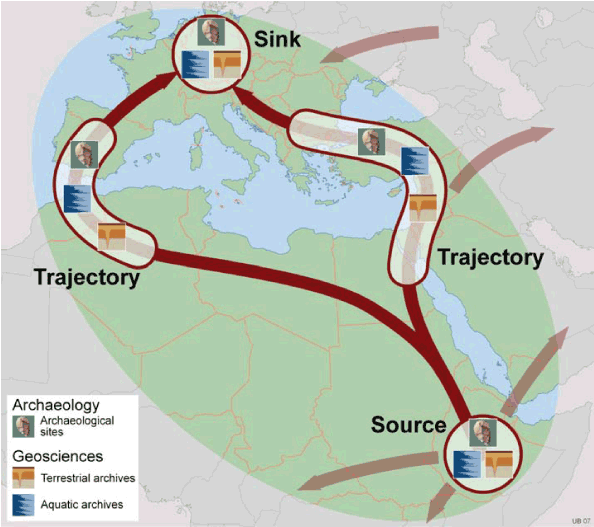 |
| Figure 1: Our Way to Europe: Origins ("source"), corridors of diffusion ("trajectories"), periphery ("sink") and key areas selected for contextual research with special respect of the adaptive width of the human niche, given by limiting natural factors in particular regions. The human niche is considered as a product of cultural, environmental and climatic factors, thus defining the three principal disciplinary branches - corresponding to archaeological, terrestrial and aquatic archives - involved in our research strategy. |
A scientific minority holds that Modern Man evolved from several distinct regional branches of Homo erectus sensu lato into the one present species. This argument, known as the “multi-regional” hypothesis, has widely been rejected. During the last decade, however, anthropologists and archaeologists have discussed several variations of both hypotheses. New data argue the possibility of more than two events of ex-Africa dispersals, as previously accepted (Out of Africa I: Homo erectus around 1.8 million years and Out of Africa II: Homo sapiens around 190,000 years ago). Furthermore, indication of possible admixture between pre-modern (e.g. Neanderthals) and Homo sapiens sapiens populations has recently been found, though controversially debated. In Europe, the earliest Homo sapiens sapiens appear around 35,000 a BP, either as a result of direct migration over the Balkans from Africa, or from a secondary source in eastern Eurasia. Multiple directions and reverse migrations have to be taken into account, including possible reflux from the Near East to Northern Africa, which has recently been indicated by genetic investigations. While most scientists agree on the principal finding of an African origin of Modern Man and subsequent dispersal resulting in the occupation of western Eurasia and other parts of the world, the rhythms and directions of dispersal remain unclear as well as the conditions and reasons underlying the processes.
The CRC will test the eastern and western corridor of dispersal from East Africa to Europe (Figure 1) – the first is proven, the second is possible - by meso- and macro-scale reconstruction of climatic indicators and by meso- and micro-scale reconstruction of environments and cultural contexts in selected key areas. Both corridors match remarkable climatic gradients for temperature and precipitation. Consequently, the CRC will establish a chain of localities with terrestrial and aquatic archives offering the opportunity to estimate the local, regional and supra-regional environmental settings in the CRC time frame. The adjacent localities, together with comparable archives and methods, guarantee the detection of the climatic and environmental history with a temporal and spatial resolution high enough to decipher its impact on the dispersal of Modern Man to Europe.
Second theme:
Secondary occurrences of expansion and retreat of our species, induced by climatic, environmental or cultural changes, for instance the re-occupation of the Near East in the Middle Weichselian and the re-occupation of extensive parts of Europe after the end of the Last Glacial Maximum resulting in the spread and establishment of Neolithic economies throughout Europe.
Whereas the first theme examines the initial spread of Homo sapiens sapiens, the second theme deals with secondary expansion, retreat and reflux into areas which had previously been occupied, but were later abandoned and resettled. This applies for the Near East concerning the ephemeral presence of Modern Man around 90,000 and re-occupation after the first glacial maximum. In Europe, the second glacial maximum between 26,000 and 18,000 devastated large parts of the continent. After deglaciation, Europe was availible again for human re-occupation from the southern refugia. Specialised hunters immigrated to Central Europe, later adapting to broad-spectrum subsistence when the climate improved. Subsequent migration processes, interlinked with cultural diffusion, caused the transition from hunter-gatherer economies to the productive economies of the Neolithic in Europe. Each single step on the long way of diffusion, from the Near East to Central Europe, has since been subject to controversial debate about the complementary importance of migration and transfer of knowledge.
In order to describe and calculate late-glacial and postglacial migration processes, the CRC will follow a particular approach for selected regions by establishing frames of estimation of population density: When sufficient archaeological data is available, it will be the target region of possible migrations, for the time before and after the expansion.
Such population dynamics were likely influenced by climatic and environmental changes and their small-scale spatial patterns as well as by culture-environment interactions. The natural changes in the time slice of the second theme had two different characters: relatively slow Milankovitch controlled glacial/interglacial cycles contrast with short-term fluctuations such as the Dansgaard/Oeschger events during the Middle Weichselian. In order to reconstruct these centennial to millennial-scale climate fluctuations and their influence on migration processes, particularly well-dated and high-resolution archives have to be investigated. The location and north-south orientation of the CRC trajectories will contribute to a better understanding of the gradients of climate indicators, the amplitude of climate impacts originating form the North Atlantic Oscillation (NAO) in the north and the North African monsoon system in the south, as well as potential leads and lags of their teleconnections. Accordingly, the multidisciplinary geoscientific research approach will provide new information on the driving forces of the long and short-term fluctuations and the reconstruction of atmospheric circulation patterns through time.
Third theme:
Population changes, mobility and migration in coupled cultural and environmental systems, driven by growing impact of human agency on the environment, particularly dispersal, retreat and internal mobility among sedentary prehistoric societies.
After the introduction of a producing economy, migrations as well as transfer of knowledge were still important. It is our hypothesis that during the Neolithic not all of the land was being used to its carrying capacity. The supporting and limiting factors for land use are still poorly understood. Of importance are, for instance knowledge and availability of agrotechnical means, the development of cultural centres, and the climate variability. Our knowledge of the so-called "sedentary societies" is much better than the one of hunter-gatherer societies. Therefore, we plan to develop a multifactor system to better understand forcing and response factors leading to regional migrations at different periods after the beginning of the Neolithic in Europe. Subsequently, this system can be transferred to other areas and time slices of the CRC.
The archaeological aspects of theme three build upon the implication provided by palaeoenvironmental data from selected key areas (e.g. vegetation, run-off, relief, sedimentation and erosion) and supplied by a number of geoscientific projects. Furthermore, specific geoarchaeological projects will trace the integral signals of cultural systems, as expressed in sizes and localities of settlement areas. The archaeological findings will, on the other hand, allow the estimation of the amount of human impact on the environment. This will support the interpretation of geoscientific archives, in particular the differentiation between natural and anthropogenic environmental changes.
Temporal Foci, Spatial Foci and Methodology
Research within the proposed programme will concentrate on six temporal foci and on four spatial foci. These foci are addressed by projects, clustered in groups (A-F and Z), of which clusters A-D are related to specific geographical regions while clusters E and F follow supra-regional approaches (Figure 2).
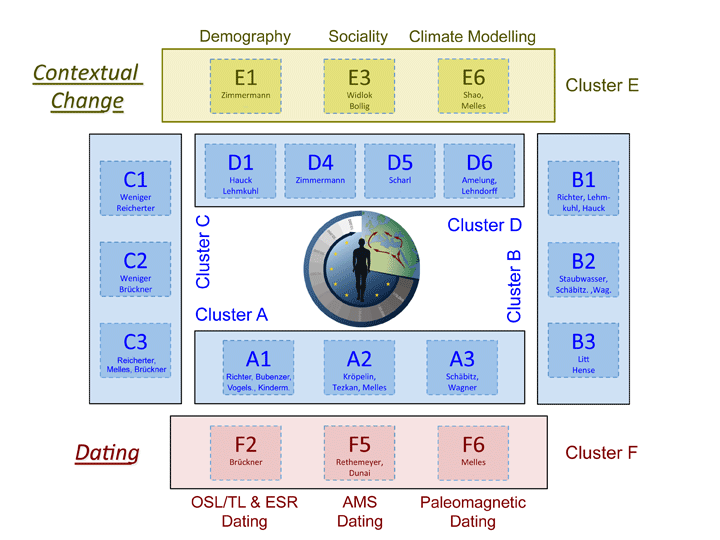 |
| Figure 2: Organisation concept of the applied CRC. The project clusters A-D conform to the main geographical regions (horizontal), while thematic fields are arranged vertically and indicated by colours. Clusters E and F deal with integrative and methodological aspects, respectively. In order to achieve maximum flexibility, three "merged projects" have been designed which combine larger, multidisciplinary research groups. |
Spatial concept of the CRC
Data collection and fieldwork will concentrate on four geographical regions in selected key areas of modern human origin, dispersal and establishment (Figure 3):
- Northeast Africa: The “source” area of the emergence of Modern Humans
- Near East, Anatolia and the Balkans: Eastern corridor of dispersal into Europe
- Northwest Africa and Iberian Peninsula: Possible western Corridor of dispersal into Europe
- Central Europe: Case study of a “sink” area of transcontinental population movements, resettlement and establishment processes
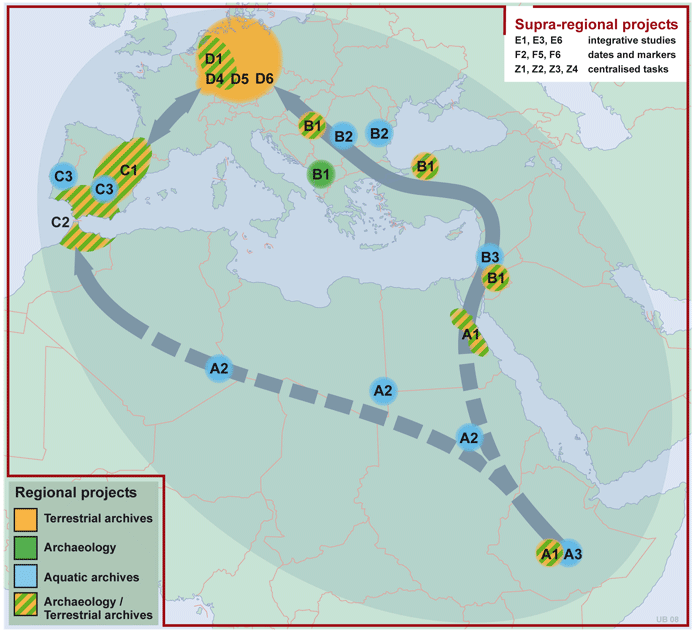 Figure 3: Geographical regions of the first and second phase of the CRC. Only the projects of the clusters A-D are related to specific fieldwork areas, while the E / F projects follow an integrative approach and are displayed in the upper right corner only. Figure 3: Geographical regions of the first and second phase of the CRC. Only the projects of the clusters A-D are related to specific fieldwork areas, while the E / F projects follow an integrative approach and are displayed in the upper right corner only. |
Time scale concept of the CRC
We defined a set of criteria to select six chronological foci to be implemented, which
-
display major temporal changes in socio-cultural systems or possible abrupt changes within the social system and
-
facilitate diachronic comparisons and
- allow for observation of population dynamics.
Our research will focus on six chronological stages, each representing a principal episode in prehistoric population dynamics (Figure 4):
- 190,000 a - 60,000 a (MIS 7/6 to 4): Emergence of Modern Man in East Africa and first dispersal into the Near East. Partial depopulation of Central Europe by the first glacial maximum of the last glacial (70,000 – 60,000 a).
- 60,000 a - 18,000 a (MIS 3/2): Resettlement of Central Europe after the first glacial maximum, immigration of Modern Man into Europe and replacement or extinction of Neanderthals, “Upper Palaeolithic Revolution”. Partial depopulation of Central Europe by the second glacial maximum (28,000 –18,000 a).
- 18,000 a - 9,600 a BC (MIS 2/1): Resettlement of Central Europe after the second glacial maximum.
- 9,600 a - 3,500 a BC: Dispersal of farming and husbandry and possible initial migrations from the Near East to Central Europe.
- 3,500 a -1,600 a BC: Farming in the "Dark Ages" in western central Europe. The mobility of later times caused either by natural or cultural factors has to be compared with earlier processes of expansion.
- Comparison with developed farming systems of later times in western central Europe.
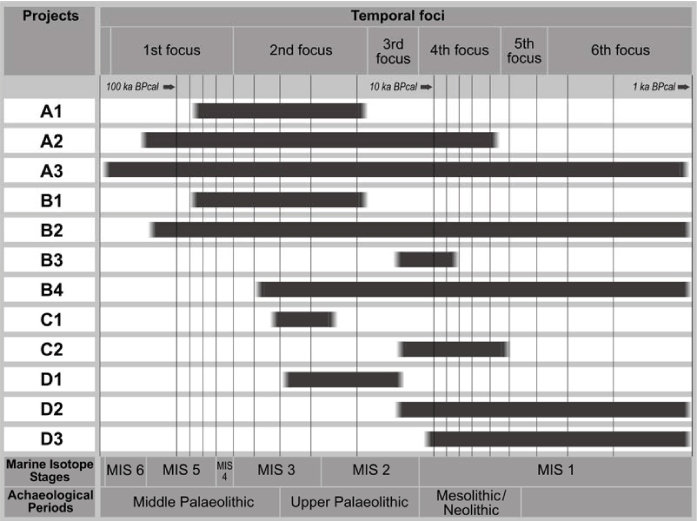 Figure 4: Chronological stages of the CRC (first project phase) and time scales of the projects (only project clusters A-D displayed). Figure 4: Chronological stages of the CRC (first project phase) and time scales of the projects (only project clusters A-D displayed). |
Methodology
A research strategy of three connected scale levels will help to interpret data within the key areas and comparison of regional data. A macro-scale perspective concerns structures and relationships within systems (climate, environment and culture) causing systemic change and diffusional processes. From this perspective, sources, trajectories and sinks of diffusional processes are reconstructed and observed on a supra-regional scale. A meso-scale perspective deals with limnic, terrestrial and archaeological archives and is designed to reconstruct regional climate and environment by observation of high resolution sediments and by cultural chronology. A micro-scale perspective centres on local site catchments. Excavations of archaeological sites, stratigraphical analysis, geoarchaeological prospection and sampling, detection of land use proxies will deliver data on local environmental parameters and their impact on human behaviour. Up- and downscaling procedures allow for connection of the different scale levels and require a particular methodology, which was developed in previous collaborative projects (e.g. RhineLUCIFS) conducted by CRC scholars in Cologne and Bonn.
